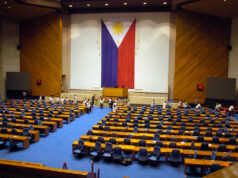Budget delay’s impact hounds infrastructure spending into July
LATE ENACTMENT of this year’s national budget continued to weigh on infrastructure spending in July, the Budget department reported on Friday, even as it noted that a month-on-month surge showed “that disbursements are starting to normalize and accelerate in the second half…”
Infrastructure and other capital outlays surged by 73.1% to P75.2 billion in July from June’s P43.5 billion, but was still 11% smaller than the P84.5 billion disbursed in July last year.
July disbursements for these items brought year-to-date spending to P386.6 billion, still 11.6% smaller than the P437.2 billion spent in last year’s first seven months.
An excerpt from the department’s report blamed “the lingering effect of the delayed approval of the 2019 budget and the [45-day public works] election ban [ahead of the May 13 midterm polls].”
“The contraction recorded mostly from lower DPWH (Department of Public Works and Highways) disbursement, however, was moderated by growth posted in the Judiciary for construction, repair and rehabilitation of courts of justice, and in the Department of National Defense for the advance payment made in connection with the purchase of military equipment under the Armed Forces of the Philippines modernization program,” the report explained.
The department said it expected improvement in succeeding months, since “[t]he implementation of new programs and projects of the DPWH and the Department of Transportation are currently under way”.
“Based on the revised disbursement program submissions of said departments, spending by the two main infrastructure agencies is heavily concentrated in the second semester,” the report read.
“This, along with the allotment releases in August, can therefore propel government spending in the second semester with the completion and/or partial completion of infrastructure works and corresponding progress billings.”
Sought for comment, Ruben Carlo O. Asuncion, chief economist of UnionBank of the Philippines, Inc., described July’s smaller-than-planned infrastructure spending as a “missed opportunity” even as the month-on-month spike showed the government’s “catch-up plan” is well under way.
For Mr. Asuncion, the government “will be able to increase spending, but may come up short of the plan to spend everything of what was planned for 2019”.
For Michael L. Ricafort, economist at Rizal Commercial Banking Corp., “underspending” could lead to “some slowdown in the broader economic/GDP growth” should it persist this quarter.
The government operated on a reenacted 2018 budget until mid-April when President Rodrigo R. Duterte signed the P3.662-trillion budget for 2019. Economic managers have blamed the late budget enactment, which left new projects unfunded in the first three-and-a-half months, for the disappointing 5.5% gross domestic product (GDP) expansion last semester. The economy now has to expand by at least 6.4% in the second semester to meet the lower end of 6-7% target this year.
Mr. Ricafort said GDP growth could “pick up” this semester and next year “due to the spill-over government spending, especially on infrastructure into 2020 (from 2019)”.
“The sharp decline in both inflation and interest rates would also help spur greater demand for loans/financing, including those for financing various infrastructure projects especially the big-ticket infrastructure projects under the ‘Build Build Build’ program, as well as those for their contractors and other suppliers that are part of their supply chain,” he said in an e-mail.
“The government’s preference for using official development assistance loans — which are cheaper and with longer tenors (with grace period) and could be much faster to implement by the government once approved (with less parties/partners do deal with) — would also help in speeding up the deployment and completion of the major/biggest infrastructure projects, especially those under the ‘Build Build Build’ program.” — Beatrice M. Laforga



